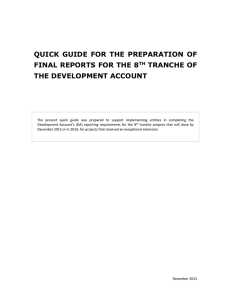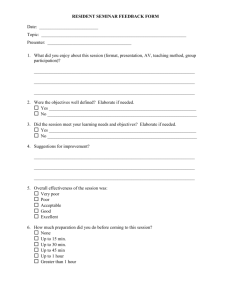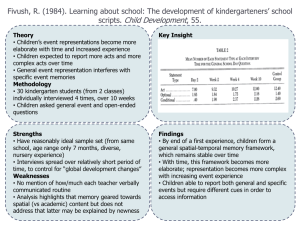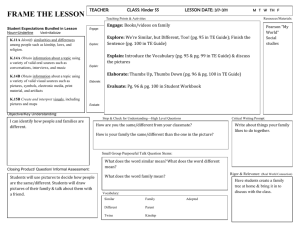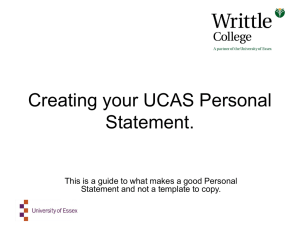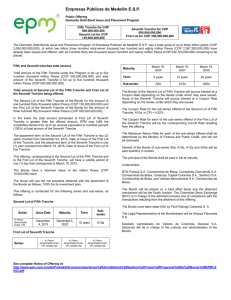Quick Quide to prepa..
advertisement
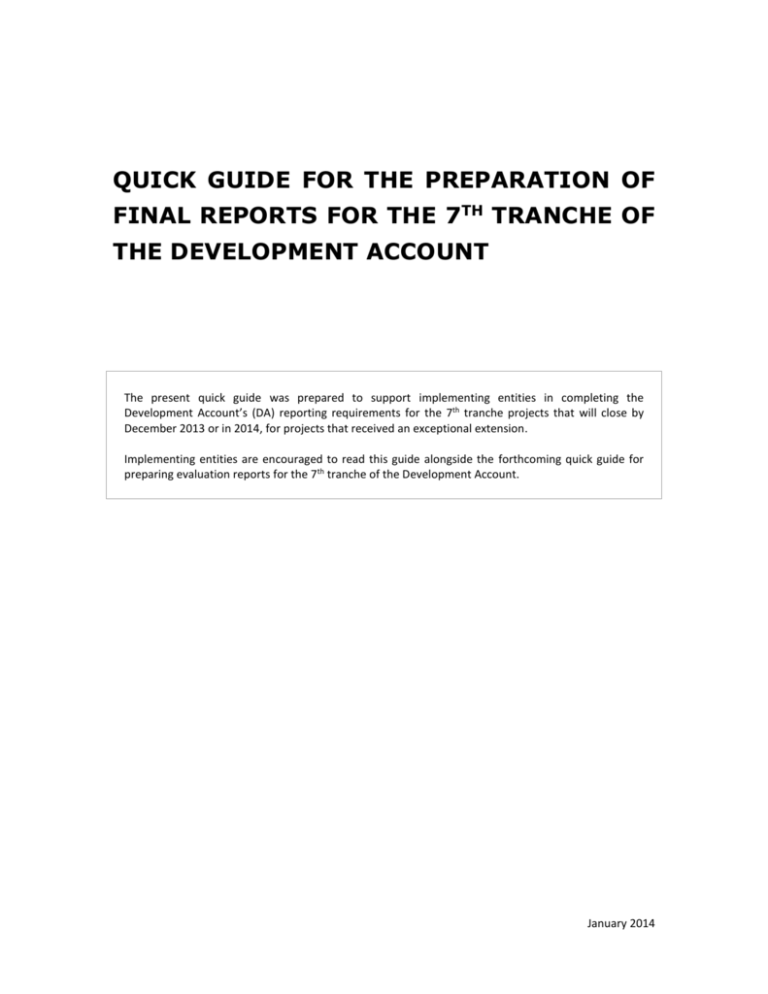
QUICK GUIDE FOR THE PREPARATION OF FINAL REPORTS FOR THE 7TH TRANCHE OF THE DEVELOPMENT ACCOUNT The present quick guide was prepared to support implementing entities in completing the Development Account’s (DA) reporting requirements for the 7th tranche projects that will close by December 2013 or in 2014, for projects that received an exceptional extension. Implementing entities are encouraged to read this guide alongside the forthcoming quick guide for preparing evaluation reports for the 7th tranche of the Development Account. January 2014 Introduction The present quick guide was developed to support project managers and Development Account Focal Points in preparing the final report to submit to the Development Account (DA) Programme Management Team (DA-PMT) upon closure of each Development Account project. It outlines key procedures and provides a template to facilitate the drafting of the final report. The present document is organized as follows: Section I defines the main purpose of a final project report for the Account; Section II provides an annotated template describing the key items of a final report for the Development Account; the annex provides the template that Development Account implementing entities should follow when preparing the final report. I. Drafting a Final Report for the Development Account ‘What’: The final report is an internal project management tool which reviews the implementation process of the project and presents the project’s outcomes and results. It provides an opportunity for the project managers within the implementing entities to summarize, upon closure of the project, the project’s achievements, outline the problems encountered, as well as the good practices and lessons learned. The final report should include a particular focus on assessing the extent to which the expected accomplishments were delivered, as illustrated by the indicators of achievement. In the final report implementing entities are also requested to elaborate on the sustainability of the projects’ efforts, the presence of multiplier effects and supplementary funding. The final report represents, together with the evaluation report, a key tool for information, learning, transparency and accountability. The assessment contained in the final report will enable implementing entities to distil lessons learned, internalize them and make adjustments for future projects. It will also help the DA Programme Manager to compile lessons learned, promote the sharing of information on good practices and report to the General Assembly on results and impacts achieved. The combination of final and evaluation reports for each completed project offers a unique opportunity to triangulate information and guarantee the soundness of the project’s findings. ‘How’: Final reports are drafted by project managers in the implementing entities and should follow the outline provided in the report template. ‘When’: the final report must be submitted to the DA-PMT no later than three months after the financial closure of the project i.e. 31st March 2014 for projects that closed by the end of 2013. Ideally, the evaluation report should be submitted with the final report. January 2014 2 Quick Guide for final reports - DA 7th tranche The table below summarizes a number of key features of the final report for Development Account projects, as compared to the annual progress report, as well as the evaluation report, which is also due three months after the operational completion of every Development Account project. Table 1 Annual Progress Report, Final Report and Evaluation Report for the Development Account: Summary table Annual Progress Report monitoring Final report Scope Internal project. Type Mandatory projects. Timeframe Should be submitted by January 31st for the preceding year. for all of DA Internal project. Mandatory projects. appraisal for all Evaluation report of Independent/external assessment of project. DA Mandatory for all DA projects with a budget of $300,000 or more. For 7th tranche projects that closed by December 2013, the final report should be submitted by 31st March 2014. For 7th tranche projects that closed by December 2013, the evaluation report should be submitted by 31st March 2014. For 7th tranche projects that received an exceptional extension, the final report should be submitted within 3 months of the project's operational closure. For 7th tranche projects that received an exceptional extension, the evaluation report should be submitted within 3 months of the project's operational closure. The evaluation report should ideally be submitted with the final report. Drafter Project manager implementing entity. Budget No financial required. in resources Project manager implementing entity. No financial required. in External consultant hired by implementing entity. resources 2% of the total budget of the project is initially budgeted to fund the evaluation. Should there be savings and need for additional funds for evaluation, the 2% figure can be revised upwards. If the proposed evaluation budget exceeds 4% of the project budget, prior approval needs to be received from the DAPMT. 3 Format Template available at: http://www.un.org/esa/dev account/projects/guidelines .html. Template contained in quick guide. The outline of the evaluation, including evaluation criteria, must be defined in the ToR for the evaluation. All evaluations should be conducted in conformity with UNEG Norms and Standards. II. Annotated Template for DA Final Reports The annexed template should be used when preparing final reports on Development Account projects in order to ensure consistency in format and content across all projects. The information reported will be made available in summarized form on the Development Account website and will provide inputs to the Development Account reports submitted to the General Assembly. In Section 1 project managers are asked to recap basic information about the project. Following a brief summary of results ( Section 2), project managers are then requested to review performance indicators and activities (Section 3), outline the challenges encountered (Section 4), describe good practices and lessons learned (Section 5) and elaborate on sustainability (Section 6), multiplier effects (Section 7) and supplementary funding (Section 8). Alongside any additional information (Section 9), project managers are finally asked to provide financial figures for the project (Section 10). 1. KEY PROJECT FEATURES I. Project title II. Project DA code III. Entity Implementing IV. Start date mm/yy Please specify the month and year in which the budget allocation was received VI. End date Please specify the month and year of the project’s completion VII. Beneficiary countries a. Original: mm/yy as per prodoc b. Actual date: mm/yy 1. __________________ 2. ___________________ ___________________ 4. __________________ January 2014 4 Quick Guide for final reports - DA 7th tranche Please provide a complete list of the countries that benefited from the project’s activities 3. ___________________ VIIII Implementing partners Please list UN System and other partners (do not include beneficiary governments) 5. … ___________________ UN system Other partners 1. __________________ 1. __________________ 2. … ___________________ 2. ___________________ … 2. SUMMARY OF RESULTS This section should be no longer than one page and should provide a concise and effective narrative of the basic accomplishments of the project. It should not repeat information already provided (for instance, information presented in the project document) but should highlight results, potential impact and any relevant achievement related to the project’s implementation (including unexpected results, both positive and negative). If the project (or one if its parts) is considered a success story it should be clearly stated in this section. The information reported in this section might be used for the DA website. 3. DETAILED REVIEW OF ACHIEVEMENTS AND IMPLEMENTATION The purpose of this section is to understand how the project actually performed against what it intended to accomplish. This should be done through the verification of the indicators of achievement that were developed in the project document as well as through an assessment of the implemented activities. Entities are kindly requested to fill in the tables below: - In Table 1 the comments column should be used to elaborate on the project’s contribution towards the achievement of the expected accomplishments; - Table 2 should list, under each expected accomplishment, the set of activities that were actually implemented by the project. For each activity listed, project managers should highlight whether the activity represents a variation from the project’s initial design (project document) and, if so, in what ways (e.g. additional activity/change in activity initially envisioned etc.). Table 1 - Review of Performance Indicators Expected Accomplishment EA1 Indicator of achievement (T0) Indicator of achievement (T1) Comments Please specify the baseline, if measured at the start of the project Please provide an estimate or actual values of the indicator at the Please elaborate on the progress made on the EA based on the indicator data or other relevant data. 5 end of the project EA2 … Table 2 - Review of Activities Activities implemented Please provide the complete list of activities implemented under the framework of the project Comments Please specify whether the activity represents a variation of the project’s design. Significant variations that took place should be explained under paragraph 4 (Challenges/problems encountered). EA1 A.1.1 A.1.2 … EA2 … … 4. CHALLENGES/PROBLEMS ENCOUNTERED Project managers are asked to elaborate on the problems faced by the project, both in terms of the project’s design (e.g. type of activities, expected accomplishments, objectives, etc.) and implementation (e.g. change in country situation, administrative processes, collaboration with partners etc.). All issues faced, as well as any action taken to address them, should be reported in the table below. Table 3 - Challenges and Actions Description of challenges Please list all challenges faced Action(s) taken to solve the issue, if any For each challenge, please indicate whether and how it was solved January 2014 6 Quick Guide for final reports - DA 7th tranche 5. GOOD PRACTICES AND KEY LESSONS LEARNED In this section entities are requested to elaborate on good practices, with respect to the design or execution of the project, which could be successfully replicated in future programming. The section should also outline any relevant finding that can be considered important lessons for future programming. 6. SUSTAINABILITY This section should elaborate on the extent to which the achievements of the project are likely to be sustained beyond its completion, leading to durable, self-sustained results. It should also include reference to any follow-up activity to the project that was implemented or initiated by the entity or other partners following the completion of the project. 7. MULTIPLIER EFFECTS This section should elaborate on whether the project triggered processes for the replication of its activities in other participating countries, non-participating countries, or, alternatively, any plan to do so. 8. SUPPLEMENTARY FUNDING This section should elaborate on whether additional funding (financial or in-kind) was leveraged to further the implementation of the project (e.g. securing additional participants at workshops, paying for venues/additional activities etc.). In addressing this section, implementing entities are asked to fill in the table below. Please note that supplementary funding does not refer to funds leveraged for projects other than the one being reviewed (follow up activities to the project or spin-offs in other countries should be reported in sections 6 and 7, respectively). Table 4 – Financial Leveraging Contributing Entity/Donor Purpose Amount raised Cash (USD) In-Kind 9. ADDITIONAL INFORMATION In this section any additional information on the project’s activities, such as relevant press clippings, media coverage, meeting reports, publications, websites etc. should be mentioned (if the information is available online, please include the relevant URLs). 7 10. FINANCIAL INFORMATION Project managers are asked to fill in the table below with accurate figures for each object class. Table 5 602 A. Budget/Allotment (as per project document) (USD) Description Object Class B. Revisions to allotments (USD) (if any) C. Total Expenditure (USD) D. Explanations to redeployments (USD) General Temporary Assistance 0111-Int. consult.: 604 0140-Nat./reg. Consultants and consult.: Expert Groups 2601-Consult. travel: 2602-Expert Group (travel): 608 612 616 618 621 Travel of staff Contractual services Operating expenses Supplies, Materials etc. Fellowships, grants and contributions 7202 Workshops: 7203 Tours: Study Total January 2014 Annex: Template for DA Final Reports 1. KEY PROJECT FEATURES I. Project title II. Project DA code III. Entity Implementing IV. Start date mm/yy Please specify the month and year in which the budget allocation was received VI. End date Please specify the month and year of the project’s completion VII. Beneficiary countries Please provide a complete list of the countries that benefited from the project’s activities a. Original: mm/yy as per prodoc b. Actual date: mm/yy 6. __________________ 7. ___________________ 8. ___________________ VIIII Implementing partners Please list UN System and other partners (do not include beneficiary governments) ___________________ 9. __________________ 10. ___________________ … UN system Other partners 3. __________________ 3. __________________ 4. … ___________________ 4. ___________________ … January 2014 2. SUMMARY OF RESULTS 3. DETAILED REVIEW OF ACHIEVEMENTS AND IMPLEMENTATION Table 1 - Review of Performance Indicators Expected Accomplishment EA1 Indicator of achievement (T0) Indicator of achievement (T1) Comments Please specify the baseline, if measured at the start of the project Please provide an estimate or actual values of the indicator at the end of the project Please elaborate on the progress made on the EA based on the indicator data or other relevant data. EA2 … Table 2 - Review of Activities Activities implemented Please provide the complete list of activities implemented under the framework of the project Comments Please specify whether the activity represents a variation of the project’s design. Significant variations that took place should be explained under paragraph 4 (Challenges/problems encountered). EA1 A.1.1 A.1.2 … EA2 … … 4. CHALLENGES/PROBLEMS ENCOUNTERED Table 3 - Challenges and Actions Description of challenges Please list all challenges faced Action(s) taken to solve the issue, if any For each challenge, please indicate whether and how it was solved January 2014 10 Quick Guide for final reports - DA 7th tranche 5. GOOD PRACTICES AND KEY LESSONS LEARNED 6. SUSTAINABILITY 7. MULTIPLIER EFFECTS 8. SUPPLEMENTARY FUNDING Table 4 – Financial Leveraging Contributing Entity/Donor Purpose Amount raised Cash (USD) In-Kind 9. ADDITIONAL INFORMATION 11 10. FINANCIAL INFORMATION Table 5 602 A. Budget/Allotment (as per project document) (USD) Description Object Class B. Revisions to allotments (USD) (if any) C. Total Expenditure (USD) D. Explanations to redeployments (USD) General Temporary Assistance 0111-Int. consult.: 604 0140-Nat./reg. Consultants and consult.: Expert Groups 2601-Consult. travel: 2602-Expert Group (travel): 608 612 616 618 621 Travel of staff Contractual services Operating expenses Supplies, Materials etc. Fellowships, grants and contributions 7202 Workshops: 7203 Tours: Study Total January 2014
